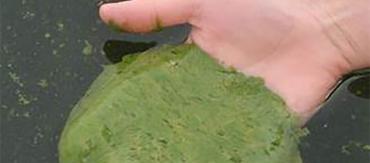By JOHN HAUGHEY THE CENTER SQUARE

Blue-green algae on the Treasure Coast in 2018
The Blue-Green Algae Task Force appointed by Gov. Ron DeSantis in January to study ways to prevent or reduce algae blooms spawned by Lake Okeechobee runoff into the Caloosahatchee and St. Lucie rivers is nearing completion of its first draft of recommendations to lawmakers.
And it’s apparently going to include data referencing “climate change” and “global warming,” words former Gov. Rick Scott forbid from being mentioned in previous state-funded efforts to address blue-green algae and red tide.
“Cyanobacteria over 3.5 billion years have adapted to just about everything,” said Dr. Valerie Paul, of the Florida Institute of Oceanography (FIO) and director of the Smithsonian Marine Station in Fort Pierce. “But warmer winters allow them to persist into our season.”
The task force reviewed its initial draft Wednesday in Naples that include recommendations related to stormwater, septic tanks and toxicology research. The panel of scientists will also call for greater investment in research and treatment of algal blooms, better procedures on the clean-up and storage of algae slurries and more intensive monitoring of wastewater spills on systems.
“These are high-level recommendations to help us move forward,” Florida Chief Science Officer Thomas Frazer said, noting the task force will continue to collect data and offer direction before the Legislature convenes in January.
Although there is extensive data documenting occurrences of blue-green algae, its potential health risks to people and animals is relatively unknown, said Dr. James Sullivan of Florida Atlantic University’s Oceanographic Institute
“The toxicology is well known but how it gets exposed is not,” he said, suggesting Florida could be a trailblazer by pursuing this line of research because it sits on the “front lines” of potential risks caused by toxins released in the air.
Among draft recommendations is to require the state’s Department of Environmental Protection (DEP) to inspect and approve septic tanks.
About 12 percent of septic tanks installed nationwide over the last decade are in Florida. Faulty septic tanks are among cited causes in high nutrient counts in some state waters.
“We need to protect against excessive pollution, which remains excessive,” said Dr. Evelyn Gaiser, an aquatic ecologist and researcher at Florida International University.
The Blue-Green Algae Task Force is one of two state-commissioned panels studying algae blooms.
The 10-member Red Tide Task Force, created by the Legislature during the 2019 session, is examining factors that spawn red tide, which devastated the Southwest Florida coast for nearly two years, causing billions in estimated economic losses for the region’s tourist industry.
Its $4.8 million budget is in addition to the $18 million lawmakers set aside over the next six years to finance Sarasota’s Mote Marine Laboratory efforts in monitoring and combating red tide.
In early September, U.S. Rep. Vern Buchanan, R-Sarasota, announced Mote Marine would receive another $1.9 million in a National Oceanic and Atmospheric Administration grant.
“This funding announcement is great news for our community,” Buchanan said. “Mote Marine works tirelessly to counter red tide and improve Florida’s water quality. I will continue my push in Congress to deliver resources to fight the plague of red tide and protect Southwest Florida’s environment.”
In August, the National Science Foundation awarded more than $1.7 million for Mote Marine’s red tide research program and in June, the National Institutes of Health set aside $6.25 million to study red tide and toxic algae.
In 2018, Buchanan helped get $100 million in federal money to fight red tide and toxic algae.
John Haughey is the Florida contributor to The Center Square.








